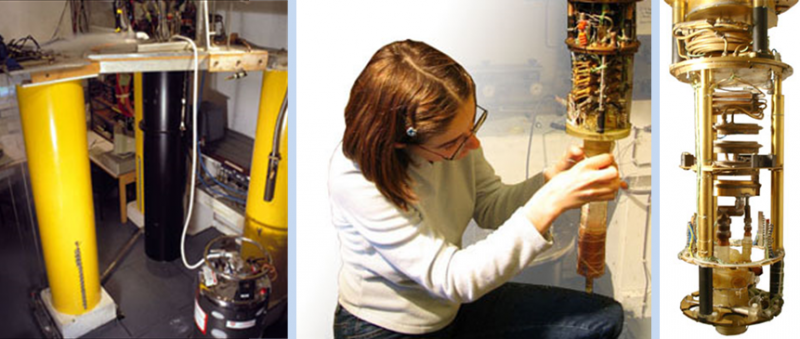
Lancaster EMP Team
Lancaster University EMP Facilities

The main instruments and support to be made available are:
-
Fridge#2.This has been refurbished several times since its construction in the late 1970's. Early experiments on this machine included the study of transport properties in 3He/4He solutions and measurements of nuclear spin-lattice relaxation in copper down to 7mK. The fridge has been used in many pioneering experiments on ballistic quasiparticles in superfluid 3He, including various Andreev scattering processes and the development of "black body radiator" techniques. It produced the first 100 mK superfluid 3He NMR experiments and the discovery of the long-lived NMR persistent precessing spin domain. This refrigerator has a custom shaped magnetic field facility which have been used to control the first-order phase transition between the A and B phases of superfluid 3He. Studies have included nucleation properties and the dynamics of the A-B interface. The interface has also been used to simulate the interaction of cosmological m-branes formed in the early Universe.
-
Fridge#4.Based on a 2.7 mK dilution refrigerator, this small machine routinely cools superfluid 3He to ~100 μK, using Lancaster-style copper nuclear cooling stages. It was used to make the first bolometric particle detection experiments in superfluid 3He-B. Recent experiments have focused on quantum turbulence, including the first direct measurement of Andreev reflection from vortices and the first direct measurements of the energy released by decaying turbulence. A new type of cooling under development based on the nuclear cooling of solid 3He layers coating silica aerogel strands will open up a new regime of superfluid 3He studies at extremely low temperatures where thermal excitations are almost completely absent.
-
Fridge#5.This cryostat is our most advanced fully-functional nuclear cooling facility. The dilution refrigerator cools to a record-low 1.75 mK. The machine has achieved lattice temperatures in copper of ~5 mK. Using Lancaster-style nuclear cooling stages, it cools superfluid 3He to record low temperatures below 100 mK. It has been used for various measurements on dirty superfluid 3He in aerogel, including the low temperature phase diagram, gapless superfluid properties and textures. In this machine quantum turbulence in superfluid 3He-B was first discovered. Recent work uses an array of quasiparticle detectors to make real-time images of quasiparticles beams and quantum turbulence generated from a vibrating wire. It has also been used for low temperature studies of solid 4He and spin ice materials. This machine has a very large experimental region and a large number of electrical leads to allow many parallel experiments on different samples and devices.
- Fridge#6.Currently being commissioned, this is the newest of the Lancaster custom made dilution refrigerators. It is expected to achieve a base temperature below 2 mK. The machine will ultimately include a double demagnetization platform to enable access to sub-millikelvin temperature measurements on quantum structures.
Personal Contact:
Feel free to discuss questions concerning possible experiments and site-relates questions directly to our Transnational Access Responsible: Viktor Tsepelin















